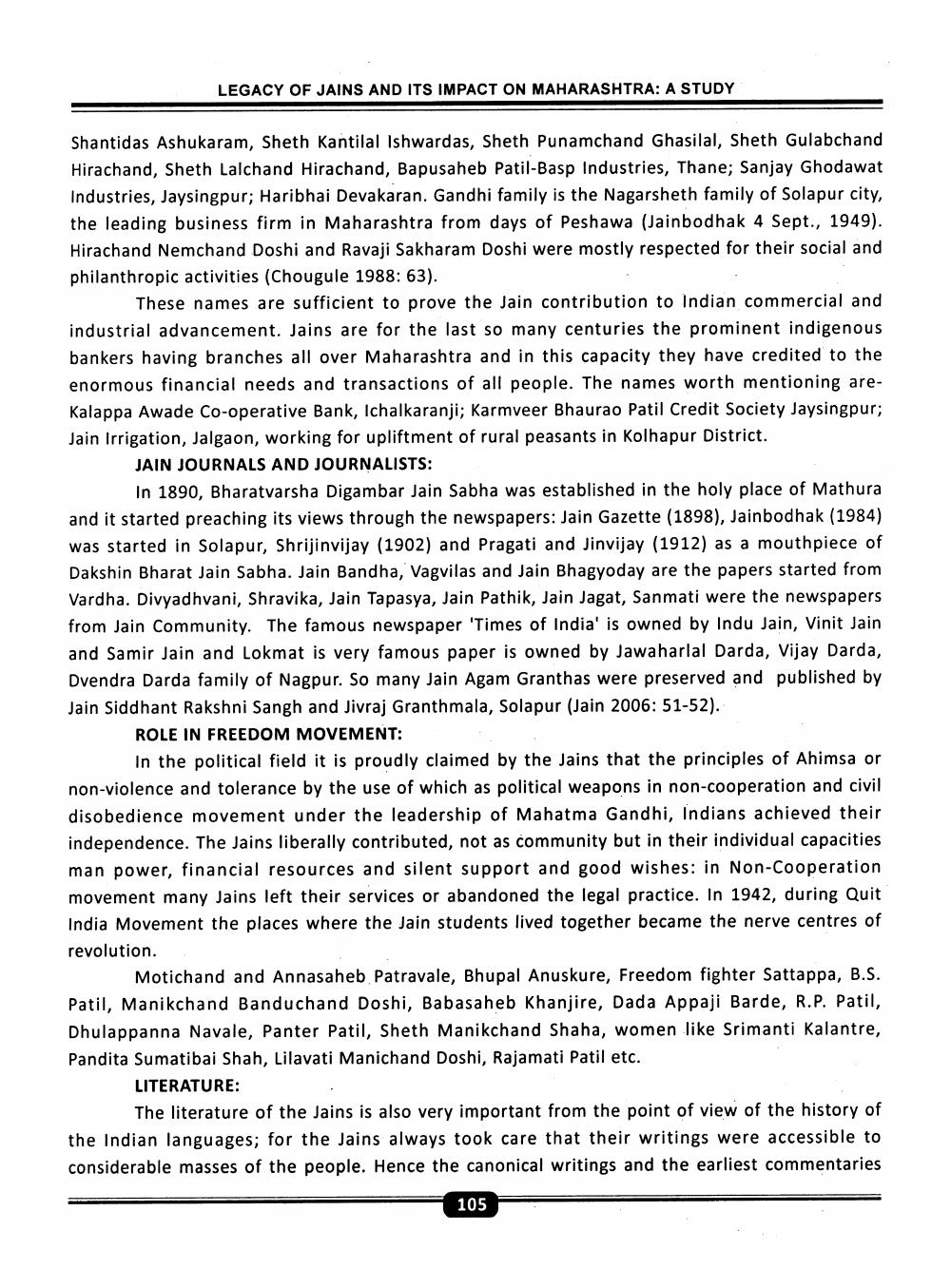________________
LEGACY OF JAINS AND ITS IMPACT ON MAHARASHTRA: A STUDY
Shantidas Ashukaram, Sheth Kantilal Ishwardas, Sheth Punamchand Ghasilal, Sheth Gulabchand Hirachand, Sheth Lalchand Hirachand, Bapusaheb Patil-Basp Industries, Thane; Sanjay Ghodawat Industries, Jaysingpur; Haribhai Devakaran. Gandhi family is the Nagarsheth family of Solapur city, the leading business firm in Maharashtra from days of Peshawa (Jainbodhak 4 Sept., 1949). Hirachand Nemchand Doshi and Ravaji Sakharam Doshi were mostly respected for their social and philanthropic activities (Chougule 1988: 63).
These names are sufficient to prove the Jain contribution to Indian commercial and industrial advancement. Jains are for the last so many centuries the prominent indigenous bankers having branches all over Maharashtra and in this capacity they have credited to the enormous financial needs and transactions of all people. The names worth mentioning areKalappa Awade Co-operative Bank, Ichalkaranji; Karmveer Bhaurao Patil Credit Society Jaysingpur; Jain Irrigation, Jalgaon, working for upliftment of rural peasants in Kolhapur District.
JAIN JOURNALS AND JOURNALISTS:
In 1890, Bharatvarsha Digambar Jain Sabha was established in the holy place of Mathura and it started preaching its views through the newspapers: Jain Gazette (1898), Jainbodhak (1984) was started in Solapur, Shrijinvijay (1902) and Pragati and Jinvijay (1912) as a mouthpiece of Dakshin Bharat Jain Sabha. Jain Bandha, Vagvilas and Jain Bhagyoday are the papers started from Vardha. Divyadhvani, Shravika, Jain Tapasya, Jain Pathik, Jain Jagat, Sanmati were the newspapers from Jain Community. The famous newspaper 'Times of India' is owned by Indu Jain, Vinit Jain and Samir Jain and Lokmat is very famous paper is owned by Jawaharlal Darda, Vijay Darda, Dvendra Darda family of Nagpur. So many Jain Agam Granthas were preserved and published by Jain Siddhant Rakshni Sangh and Jivraj Granthmala, Solapur (Jain 2006: 51-52).
ROLE IN FREEDOM MOVEMENT:
In the political field it is proudly claimed by the Jains that the principles of Ahimsa or non-violence and tolerance by the use of which as political weapons in non-cooperation and civil disobedience movement under the leadership of Mahatma Gandhi, Indians achieved their independence. The Jains liberally contributed, not as community but in their individual capacities man power, financial resources and silent support and good wishes: in Non-Cooperation movement many Jains left their services or abandoned the legal practice. In 1942, during Quit India Movement the places where the Jain students lived together became the nerve centres of revolution.
Motichand and Annasaheb Patravale, Bhupal Anuskure, Freedom fighter Sattappa, B.S. Patil, Manikchand Banduchand Doshi, Babasaheb Khanjire, Dada Appaji Barde, R.P. Patil, Dhulappanna Navale, Panter Patil, Sheth Manikchand Shaha, women like Srimanti Kalantre, Pandita Sumatibai Shah, Lilavati Manichand Doshi, Rajamati Patil etc.
LITERATURE:
The literature of the Jains is also very important from the point of view of the history of the Indian languages; for the Jains always took care that their writings were accessible to considerable masses of the people. Hence the canonical writings and the earliest commentaries
105




